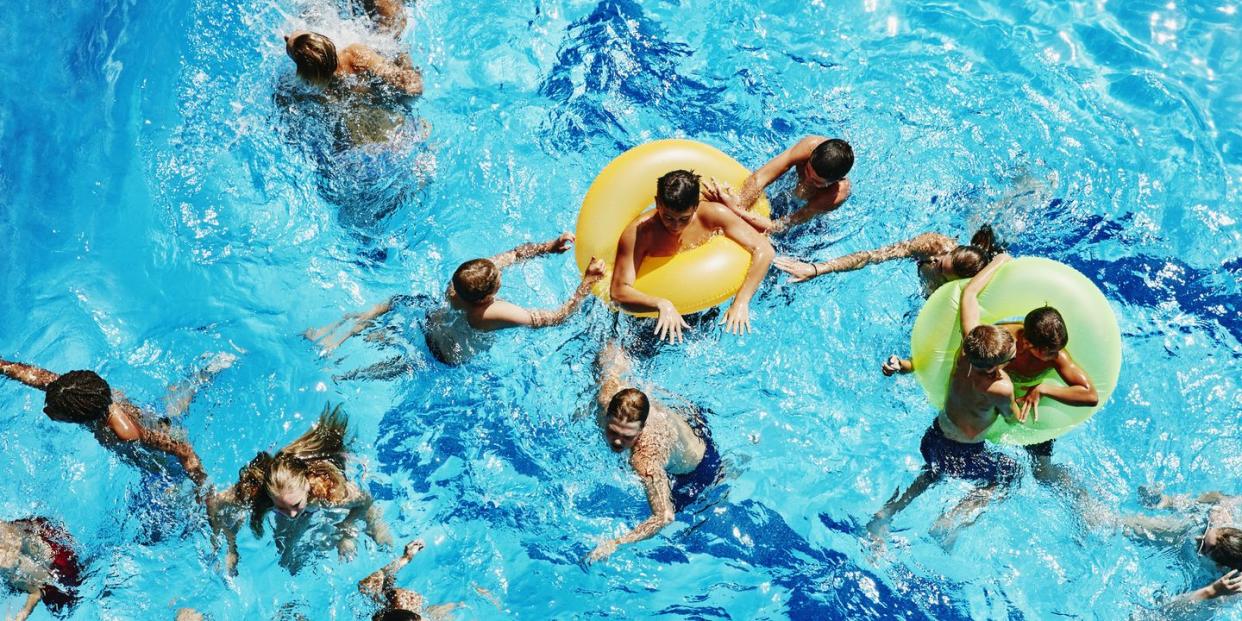A Doctor Explains How to Enjoy Pools Safely During the Coronavirus Pandemic

Some states are starting to reopen public pools after being closed due to the coronavirus pandemic.
The water itself might actually be the safest part of public pools, but you should still follow social distancing guidelines.
An infectious disease expert shares safety tips for avoiding COVID-19 transmission at the pool.
This summer may bring record-breaking temperatures, and with no end to the COVID-19 pandemic in sight, people without a way to cool off at home are left wondering whether it’s safe to brave the crowds and enjoy a swim at their local public pool, at least in the states that have partially reopened.
“Public pools are a little bit tricky,” says Bill Miller, M.D., infectious disease expert and senior associate dean of research and professor of epidemiology at Ohio State University. “The most important thing that public pools have going for them is that they’re outdoors. When you’re outdoors, you have more airflow.”
But despite the ventilation, areas like entrances, locker rooms, and snack bars could still be sites of coronavirus transmission. In fact, spending time in the water may actually pose the lowest risk—as long as you avoid crowds. Here’s everything you need to know about staying safe at public pools this summer.
At the entrance
During peak hours, there could be lots of people trying to get into the pool—so it’s still important to wear a mask when possible. The Centers for Disease Control and Prevention (CDC) released guidelines for pools and recommends the use of a cloth face covering “as feasible” or “when physical distancing is difficult.” (It’s worth noting that face mask rules will likely vary on management of the facility and state ordinances.)
Then, “don’t bunch up in the line,” Dr. Miller advises. “Ideally, it would be best to go in more off-peak hours, if there are any.” When waiting, maintain a six-foot distance from others, just like you would at the grocery store or the post office.
Dr. Miller uses a simple rhyme to assess the risk in spaces like public pools: “time, space, people, place.” These four words, respectively, act as reminders to limit your exposure to people outside of your home, maintain physical distancing, interact primarily with people who are also taking safety measures seriously, and linger only in spaces with good ventilation.
In the water
“The pool itself should be safe, generally speaking, as long as people are staying away from one another,” Dr. Miller says. “The good thing about pool water is that it’s heavily chlorinated, so most organisms don’t survive very well in [it].” Any potentially active bits of the novel coronavirus will likely be neutralized in the water, he says. The CDC also confirms that there is no evidence that COVID-19 can spread to people through recreational waters (including lakes, oceans, and chemically-treated public pools).
But that doesn’t mean the water will be entirely safe. “The challenge there is going to be, of course, kids that want to roughhouse and play with one another,” Dr. Miller says. “The other challenge is how crowded the pool is in general, and that includes both the water space and around the pool.” Your safest bet is to distance yourself from others while you go in for a dip. Do not wear a face mask in the water, as they can be hard to breathe through once they’re soaked.
On the pool deck and lawn
Management “should be trying to space the chairs and tables around the pool so that there’s less mingling there,” Dr. Miller says. Your goal, per CDC recommendations, should be to keep at least six feet away from people who live outside of your household. Kids from the same home, for example, can play together safely, but letting them interact closely with others is riskier.
“The transmission that might occur at a pool is just the same as it would be in any other context,” Dr. Miller notes. “It’s primarily respiratory, meaning that it’s going to spread from people talking to one another, breathing on one another, coughing, and sneezing.” Wear a mask when distancing is tough and keep hand sanitizer nearby in case you have to touch objects that others come in contact with.
At the snack bar
“If you’re going to purchase food at a public pool, I’m not worried about the people providing the food,” Dr. Miller says, “because there hasn’t been demonstrated transmission by food.” The biggest danger, he notes, is standing in line and waiting for your order in a group. If you brought food to the pool, the risk of exposure is lower, Dr. Miller says, but it won’t hurt to thoroughly wash your hands before you chow down. Use a squirt of hand sanitizer if you can’t get to a sink.
In the locker room
“In my experience at public pools, the bathrooms and locker rooms are not the most well-ventilated spaces,” Dr. Miller says. “There’s potential that the virus can linger in the air for some period of time, and you’re exposed to someone who was there before you.”
Miller recommends showering and changing before you get to the pool and after you get home to limit your time in these spaces. To minimize surface exposure to pathogens, wash your hands well after using the bathroom or locker room, and avoid touching your face (especially your mouth, nose, and eyes) or cell phone before you wash up.
Support from readers like you helps us do our best work. Go here to subscribe to Prevention and get 12 FREE gifts. And sign up for our FREE newsletter here for daily health, nutrition, and fitness advice.
You Might Also Like

